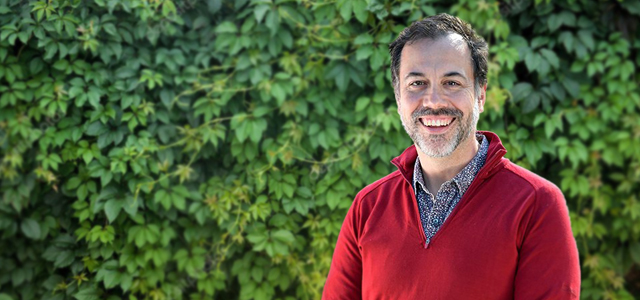Dr Anthony Rees has been a faculty member of United Theological College since 2015. His current areas of research include the construction of gender in the Old Testament and, scriptural conceptions of peace. Most days you can find him enjoying an espresso, expressing frustration regarding certain sporting teams he follows, and enjoying time with his family: his wife Natalie, sons Levi (15), Jesse (11) and Kohen (2), and daughters Nelly (8) and Summer (8 weeks).
Dr Rees recently presented the 2019 UTC Opening Lecture. His presentation “On patting snakes and sitting under trees” explored the biblical notions of peace and contextualised in a modern world. Here, we do a quick Q&A with Anthony about his presentation and the year ahead.
On Patting Snakes and Sitting Under Trees was the topic of the Opening Lecture of 2019 at United Theological College. Where did the inspiration for this lecture come from?
For a while now I have been thinking about biblical notions of peace, and the inaugural lecture was an opportunity for me to bring together a few of these ideas. The title is drawn from the two major biblical texts which I use in the paper: Isaiah 11 and Micah 4.
What are the key ideas of the lecture and its themes?
The lecture is largely about Just Peace theory, a relatively new theory which has emerged from frustration with Just War theory, a much older and well developed theory. The Just War Theory gives the conditions for the appropriate exercise of war, but more commonly, a doctrine used to justify military engagement rather than avoid it.
Just Peace theory counters this tendency towards military aggression, and seeks to de-escalate tensions and conflicts in a way that brings restoration and healing to broken relationships.
Just Peace theory isn’t a religious idea, but it should be reasonably clear that religion has a lot to contribute to any discussion of peace for a number of reasons.
The two most significant reasons form a cruel paradox: Peace is a significant virtue in most major religions, and so understanding how peace is imagined in the context of particular religious frameworks provides a fruitful starting point for discussion.
The paradoxical point is that so much conflict and violence in the world comes as a result of religious identification. Are religious ideas or religious people the best sources for constructing peace?
I don’t argue here that the prophets provide the framework for peace, but I make a case that in these two texts an image of the world at peace is presented. Both have an ecological framework: in Isaiah, peace is imagined in the harmonious relations between natural enemies (lions and lambs lying down together and so on), and in Micah, people sit under the shade of their own trees with no reason to be afraid.
Too often, images like this are pushed into the future so that they are held to be utopian. I want to say that we need to have a greater sense of optimism for our world. These images need not be utopian: they are models for us to work towards, calling us to the hard work of reconciliation and peace building, and to recognition of the reality of human dignity.
You love to mix contemporary thinking with historical theological ideas – where do they intersect here?
In a world which is divided along all sorts of fault lines, we need to mine our tradition for resources to help us deal with the realities of our own day.
Understanding the historical context of Isaiah and Micah is important. These texts are about 2800 years old, and come from an altogether different place. But they talk about human dignity, about human creativity, and about the possibility of a world configured differently to the way it is. It seems to me that they are wrestling with the same ideas as us.
So, we have a choice: we can decide that 2800 years later, nothing has changed and we are all hopelessly doomed. Or we can decide to believe the world can be different. Of course, it isn’t enough to decide the world can be different. That decision has to be coupled with action, which is why I talk about the hard work of peacemaking.
With the new educational year upon us, what are your hopes for the students and their educational journey?
As always, we hope that students learn more about God, themselves, and their place in the world. We hope that the tools we use in our classes provide fruitful means to examine our world, ourselves, and the communities that have formed us, and a vision of how all those things can be transformed by the gospel. I always hope that students will hang on through the moments of difficulty and struggle that serious attention to scripture brings to us, because it is in those moments that we learn, grow, and develop in our capacity to read faithfully. I love the scriptures, and I hope that in some small way I can help the students love scripture more too.















1 thought on “Q&A with Dr Anthony Rees”
I value the brief article Q&A with Dr Anthony Rees. It is wonderful to see the concepts “peacebuilding” and “justpeace” presented. A third seminal text from Hebrew Scriptures for me is the reconciliation psalm, Psalm 85, in which mercy and truth embrace whilst justice and peace kiss. As peacebuilder, John-Paul Lederach, writes, “What is this place called where mercy, truth, justice and peace come together?” ‘Tis the place of reconciliation.